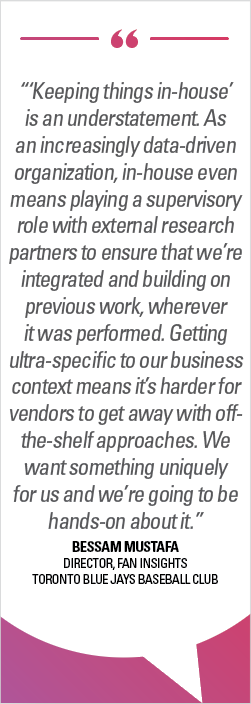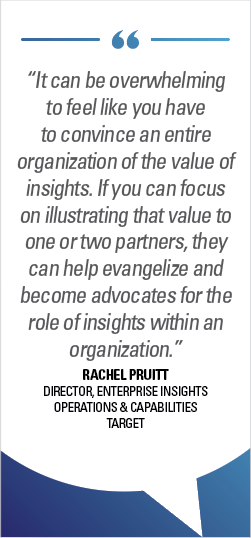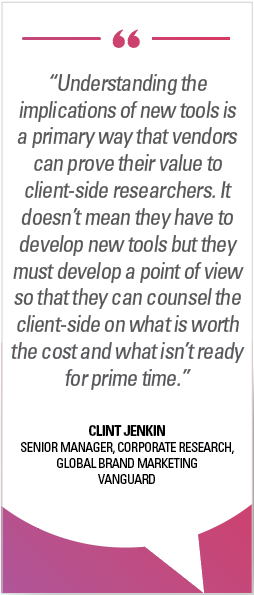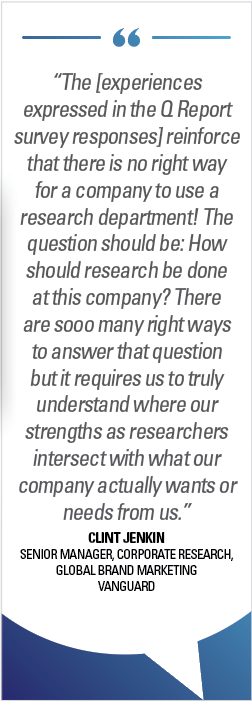Fighting the good fight
For this, our tenth annual Q Report, we are shaking things up a bit! Instead of presenting all the data in one issue, we’re going to spread our coverage out across the magazine and our digital outlets over the next several months, starting with a regular Q Report feature in each bimonthly issue of the magazine and some occasional Quirk’s e-newsletter articles as well. In the next issue of the magazine, for example, we will look at the responses to our question from this year’s survey about respondents’ plans for using generative AI. Early-2024 issues will cover topics like outsourcing and vendor communication.
The Q Report work life and salary and compensation study of end-client/corporate researchers is based on data gathered from an invite-only online survey sent to pre-qualified marketing research subscribers of Quirk’s. The survey was fielded from May 24 to July 10, 2023. In total we received 1,969 usable qualified responses, of which 707 were from end-client researchers and used for this end-client report. An interval (margin of error) of 2.17 at the 95% confidence level was achieved for the entire study. (Not all respondents answered all questions.)
For my annual overview piece, we will focus on the following: the changes respondents said they foresee their organizations making related to marketing research in the coming year; the areas in which they would most like to improve communication with internal departments and stakeholders; their thoughts on why stakeholders have not included the insights function in important business decisions; and their assessment of the available marketing research tools and methods. Elsewhere in this issue our team will look at some job- and employment-related topics around work satisfaction, hiring plans and the importance of workplace flexibility.
We’ve always viewed the Q Report as more of snapshot in time than an assessment of the state of the industry. Our goal has been to give readers a way to benchmark their situations and experiences with those of their peers and also provide a forum for them to express in their own words the highs and lows of working in marketing research. If there are topics you’d like us to cover or questions you’d like us to ask in future Q Report surveys, please let me know at joe@quirks.com.
What’s ahead in the coming year?
Two alphabetisms were common response choices to the question about the biggest marketing research-related change readers foresaw their organizations making in the coming year: AI and DIY. The AI responses typically were quite short – often just “AI” – with most centering around incorporating AI in some unspecified manner – a vagueness that’s understandable given AI’s newness and the lack of clarity surrounding its potential use and impacts.
On the DIY front, researchers’ definition of DIY seems to have morphed from one that used to refer to rogue internal clients sending out surveys on their own without consulting the insights team to a definition that basically means “we’re keeping things in-house.”

Budgets were slashed this year, meaning very little ad-hoc, strategic work will happen unless internal clients have funding. We are mainly focused on core research surrounding product development and communications and brand health. We continue to do 90%+ of the work DIY.
Doing more and more quick, agile projects with a DIY aspect and fewer larger full-service projects.
Trying to do more agile market research – perception is that market research is slow/slows down innovation.
In that same vein, automation was mentioned several times, adding to the general sense that respondents are having to work quickly and efficiently to keep up. No themes emerged from the comments to shed light on what’s driving their focus on speed and efficiency. In past years it’s been down to the old “better, faster, cheaper” mantra but this year it just feels like researchers are under the same strains affecting those of us living in this digital age: everything everywhere all at once.
We are constantly pressured to automatize our work and provide quicker results but also a wider perspective. In this regard, we are pushed to work more often with big data rather than do research from scratch. Also, we are encouraged to adopt as many things that are presented as being innovation or emerging tech.
Another notable change is a movement away from mass surveying and its anonymous outputs and toward more personal forms of data-gathering, chiefly qualitative research-based, which offer the twin merits of immediacy and vitality. After all, nothing brings a consumer segment to life better than a video clip from a one-on-one or a focus group.
Likely moving away from traditional feedback surveys and moving towards qualitative (IDIs) with customers. Definitely moving away from a big market/competitive study.
Emphasis will be on getting authentic video content as opposed to purely large-sample-size quant studies.
Still, not everyone is seeing qualitative approaches win out.
Sadly, I think current trend will continue – less deep ethnography and robust qual to deeply understand customers and more monitoring of buzz, aka “real-time insights,” which aren’t true customer insights at all, just a bright shiny superficial appearance of customer “closeness” that creates a ton of busywork and churn but is useless for making critical strategic decisions.
Also, more interest in being predictive rather than reactive.
Anticipate trends and translate them into a competitive advantage, use big data to generate insights, look into generative AI.
And in the spirit of “a journey of a thousand miles begins with a single step,” one hopeful soul offered this assessment of their biggest upcoming change:
We expect to conduct research for the first time in several years.
There were mentions of hiring more staff (yay!), getting innovative by adding new tools to the toolbox and some plans to move to or incorporate non-research-gathered forms of data:
Pivot from original market research to CX, social media listening, mining complaints data, etc. Elimination of research-based approaches, looking to replace with transactional insights.
We are making increased efforts to integrate our market research data across functions and with other types of data (operational, social media, complaints and grievances, etc.).
As always, budgets loom as a concern.
Cost-cutting; fewer big projects; cheaper surveys. No longer understand what it takes to get true insights, not answers to basic superficial questions.
I’d like to be part of the strategic planning and budgeting process. Failures to budget and understand what is involved in doing research correctly (and the steps involved and the time it takes) are prevalent.
But on the flipside, there were reports of expansions of the marketing research budget!
We are heavily investing on our ability to more strongly evangelize our research, connecting the dots on CX and CI, building out a team to support a new line of business that is the future of the company, hiring talent and training to help us think long-term. More than one thing but there is a lot going on within our team!
How would you improve communication?
We asked respondents to think of a time when internal stakeholders didn’t include the insights function in important business decisions and gave them a list of possible reasons. At 26%, lack of awareness of the insights function’s capabilities was the top choice, followed by stakeholders using other internal data to understand the issue (21%), the insights function being viewed as too slow (16%) and stakeholders not seeing the value in gathering customer feedback (12%).
How do you turn the tide on all of the above? Better communication!
We asked readers an open-end about the areas in which they’d most like to improve their communication with internal audiences and stakeholders. A critical part of communication, of course, is language and in reading through the verbatims it’s clear that, just as politicians (or, more correctly, their consultants and PR handlers) have become masters at using language to frame issues (Republicans say “illegal aliens,” Democrats say “undocumented workers”), so too might it benefit researchers to listen to and try to change the ways marketing research is talked about within their organizations. For example, instead of being used to kill ideas, research is for reducing risk; rather than a cost on a balance sheet, research is an investment in success; using research to bolster decision-making is smart, it’s not an indication of weakness.
Most just want to use their gut. Some see the need for research as a sign of an inability to think for themselves.
Whether it’s for new product development or testing an ad campaign, several readers said they’d love to drive home the point internally that research should be seen as part of the process, not a late-stage afterthought.
I would like to do a better job of conveying the importance of including insights early in the decision process and starting with survey objectives and a data analysis plan. Too often, stakeholders e-mail me a Word document with a list of questions and ask me to do a survey.
Need to get in the cycle earlier instead of finding out about projects/changes late in the game.
Need to increase awareness of insights team so we are seen as the first step in any process to gather customer insights or develop products.
 And a big aspect of doing that is trumpeting far and wide the reasons why internal clients should WANT to get research involved at the outset.
And a big aspect of doing that is trumpeting far and wide the reasons why internal clients should WANT to get research involved at the outset.
Ensuring they understand our capabilities and value-add and the importance of including us at the very beginning of the process.
[Need to communicate internally] about the breadth of our capabilities and the varying ways in which insights can improve outcomes and decision-making.
While we have strong CX buy-in from our highest-level executives, I think on occasion some leaders fear that the CX/VOC data will show a result that works against what they really want to do for revenue or other purposes. While we’ve done a good job of showing that we have the best interest of the company and other departments in mind, I think anything that would help us continue to prove that we are a partner and not a barrier would be beneficial.
How do you do that? Readers have some ideas.
Continued conversations with as many stakeholders and departments as possible.
We have a fairly good approach to communicating value. Global blog posts on our function and lunch-and-learns seem to work.
Increased dashboards and data visualization tools for stakeholder teams, streamlined reporting.
We meet quarterly with executive team to update on projects and trends.
More work needs to be done on storytelling, providing recommendations and helping push forward change based on insights.
Get them to see that research (because we are a separate P&L) are not “taking” client’s budget from them; we are hoping to build client’s spend over time so everyone gets a bigger slice of the pie.
Related, our survey respondents talked about the need to communicate that saving money by NOT doing research can end up costing a lot of money in the long run when untested products or services fail in the marketplace.
Budget constraints are big here this year. Not sure how to communicate that making decisions without consumer primary research can be a poor choice if we are relying on subjective internal opinions.
The importance of customer feedback and how much more effective our features/efforts could be if we grounded them in solving for a customer pain point.
Demonstrating that there are time-saving cases for using market research to gut-check creative decisions. Not all research has to be traditional or artisanal to get actionable results – I’m always looking for something that is flexible and fast.
Though of course there are situations where research IS the final say, putting the researchers in the unenviable role of dream-killer.
Honestly, I would like to not have to say “no” to so many poor decisions. (Some colleagues call me Dr. No.) But the research data brings a lot of bad decisions down to Earth.
Some place the onus on the researcher to bust out their communication skills to prove their value.
My unique situation is dealing with stakeholders that are desperate for research (they have seen the value since a lot of these individuals worked for sophisticated [tech] organizations) but sometimes they lack the understanding of what research can and cannot be used for.
Sharing more of our capabilities and bringing them up to date on the fact that research investments don’t have to cost so much and don’t have to take so long. There’s a lot of misinformation about these things.
Pulling consumer understanding/insights through from marketing/media/creative all the way through to sales results for sales organization to leverage as evidence!
Sharing less data and more data-driven ideas.
Researchers can also further their own cause by doing the detective work to investigate how the company functions, who is in charge of what, etc.
[It would help to have a] better understanding of my employer’s complex org structure to know who to make aware of insights capabilities; better understanding of what pockets of research already exist in the company.
Need better understanding of other department needs and how the insights function can help them so that a “sales pitch” can be developed from making those connections.
Despite their best communication efforts, sometimes the audience they’re trying to reach simply isn’t interested in what they have to say. Many responses fell into the “it’s not us, it’s them” category, with the “them” most often being the folks in marketing.
I think the problem is not about improving communication from my side or my dept. The real issue is that our company is too marketing-oriented, meaning that the marketing dept has a very, very hard time accepting that consumers do not like their ideas or proposals. Marketing people are not able to critically reflect on their work.
Marketing dept is full of lifers who don’t want interference with what they decide to do. Most uncooperative dept.
Stakeholders don’t like when data shows that they are performing poorly, so they prefer collecting their own metrics that make them look good.
And sometimes there’s only so much one person (and many insights functions are just one person!) can do.
It’s a bigger issue than me. We need an overall ethos change in which research is valued and operationally inserted into product roadmaps and every department’s strategic plan. It’s not up to me to singlehandedly fix a system that is by and large ignorant of research.
It would just be nice to be able to see action based on our research findings on the innovation side of things. We tend to be classified as more reactive than proactive and when we are proactive, it is not well received.
Stakeholders have a vested interest in “leading” decision-making – even though we purport to be an “insights-led” organization.
But thankfully, for many respondents, the communication work they’ve already done has things working pretty well.
I think my company has good communication among internal departments as it stands. For the most part, the insights function is viewed as important and we are included in business decisions.
We have a solid, trusting relationship with our other departments. If anything, they would probably love to receive more insights from us for inclusion in decisions.
My company has complete buy-in for the consumer insights function – they don’t make decisions without it.
My insights department is very visible and utilized by C-suite executives on a regular basis across the entire organization. When we are not used for something, the failures of the campaigns are corrected by the insights team and ROI is proven.
How effective are the tools and methods available to you?
It feels like we are at an inflection point with marketing research tools and technology, with the impacts and capabilities of AI being explored and defined right now. Will AI fundamentally alter the marketing research process? Or will it join a number of other supposedly game-changing tools that were buzzed about and then faded?
We asked an open-end about the effectiveness of the tools that researchers do have at their disposal and what capabilities the respondents feel are missing from them. Overall, the researchers said the current tools are effective but a majority of the comments were of the yes-but variety, expressing some variation of the view that the tools and methods are fine but there’s not enough time, budget or staff to get the most out of them.

I think there are a lot of great tools to deeply understand consumers but it does take time to do it AND communicate effectively, in a storytelling way, across the organization. I strongly believe that AI will enable us to accelerate and improve.
Every day my consumer insights department is getting better and better at knowing who our customers are. Figuring out products that are available to us that we can use is our biggest challenge, [along with] doing research with a limited number of personnel. Not enough hours in the day.
They’re effective … but our corporate overlords are too cheap to pay for them.
We are 90% DIY. There are three of us. It can be overwhelming to get everything done. Efficiency with one tool suffers when I need to switch gears and work with a different one, e.g., quant then qual and then develop report/presentation and socialize. I sometimes need to relearn functions within platforms as I go back and forth quite a bit.
Some comments were reflective of the niche the respondent works in:
Our targets are typically older, less affluent and in poor health, making it harder to engage with them digitally. Other high-touch methods (in-person, phone, etc.) are not always practical.
My struggle is that I need something that is defensible to federal clients (who have concerns about data privacy) but is also lean and nimble enough that I’m not soaking my budgets with several-thousand-dollar costs outside of labor. We’re contractors, so those are things we have to “eat.” The time spent on less-efficient but cheaper tools can sometimes be offset by the fact you can bill that time.
I think there are a lot of great tools for product marketers and market research. But when it comes to non-profits and charitable giving, the tools don’t quite fit or are way out of budget.
As a B2B organization, decision makers prefer face-to-face interactions with key decision makers and that is difficult to replicate with formal market research.
And as with previous questions in previous Q Report surveys, worries about response rates, sample and fraud were commonly expressed.
I mainly question survey respondent quality. The traditional survey panel method/online 15-minute survey feels very outdated but I have found few viable alternatives. Some exist but get very costly when you need meaningful sample size.
[Tools are] somewhat effective but open to great risks associated with bots, fraud. We need better representation of our customer base and the market that’s quick and cost-effective but also with controls building to reduce the risks of fraud.
I think the capabilities in the industry are broadly there and evolving at the same time. My take is the industry evolved in a way that capabilities are less about solving specific problems and more about emphasizing bright and shiny objects. And sometimes, the level of investment does not match the business importance of the research objectives.
Also a variety of comments along the lines of “the tools are fine; the organization’s the problem.”

We should be able to understand natural language from customer feedback instead of using closed questions. Some of the main problems/pains are not listed or don’t represent customers’ feelings and it takes time until we realize we are not capturing the real problem. In addition, in our org, CX and insights are not sufficiently integrated/could create more synergies to get a better and faster understanding of customers.
The company prefers to do most things DIY and it takes so much time from the actual research. They are very hesitant to spend any money on tools because they have been doing it this way and it has been incredibly difficult in challenging the status quo when you’re the only one challenging it.


As to what they’d like to see in future tools…

We currently pay for a survey platform, which we’re happy with mainly because it’s cheap, and a text analysis tool, which we are, in my opinion, paying far too much for what we’re getting out of it. I would love a cost-effective, easy-to-use text analysis tool. Everything else I’d like to be using is simply not feasible given our budgets – I have to fight to get people to cough up $6k for two focus groups.
There needs to be an easier way for marketing researchers not versed in SQL or Python to append customer, transactional and operational data to survey data collected for richer insights. It’s a steep learning curve and I’m hopeful generative AI can help with this challenge.
It’s ever-evolving, right? In my current role, I see a need to be able to condense vast amounts of unstructured data and I think the next frontier is in figuring out how to report this data in a meaningful and concise way.
They are effective but we are missing/needing more help with social listening and compiling findings from open-end feedback and other data around experiences.
We gather significant information from digital/online customers, however we cannot gather the same level of information from retail customers who make up the majority of our player base. We need a full customer-loyalty program that tracks actual purchase spending at retail to really tailor our messaging and enhance our overall performance.
We (the industry) seem to be getting there. I’d still like to see more options for online platforms where analysis, insights-generation and reporting can become quicker through AI automation. It would be great to be able to spend less time reviewing responses and more time reviewing potential insights.
We tend to be stuck with DIY solutions because agencies tend not to be able to provide us with our niche audience with their panels. Always frustrating to see very interesting things being presented at Quirk’s Events that I know we will never be able to do because of those limitations. I guess we get enough to understand customers but I would like to do more.
